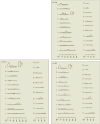Genome-wide linkage scan for quantitative trait loci underlying normal variation in heel bone ultrasound measures
- PMID: 22237995
- PMCID: PMC3928037
- DOI: 10.1007/s12603-011-0080-y
Genome-wide linkage scan for quantitative trait loci underlying normal variation in heel bone ultrasound measures
Abstract
Quantitative ultrasound (QUS) traits are correlated with bone mineral density (BMD), but predict risk for future fracture independent of BMD. Only a few studies, however, have sought to identify specific genes influencing calcaneal QUS measures. The aim of this study was to conduct a genome-wide linkage scan to identify quantitative trait loci (QTL) influencing normal variation in QUS traits. QUS measures were collected from a total of 719 individuals (336 males and 383 females) from the Fels Longitudinal Study who have been genotyped and have at least one set of QUS measurements. Participants ranged in age from 18.0 to 96.6 years and were distributed across 110 nuclear and extended families. Using the Sahara ® bone sonometer, broadband ultrasound attenuation (BUA), speed of sound (SOS) and stiffness index (QUI) were collected from the right heel. Variance components based linkage analysis was performed on the three traits using 400 polymorphic short tandem repeat (STR) markers spaced approximately 10 cM apart across the autosomes to identify QTL influencing the QUS traits. Age, sex, and other significant covariates were simultaneously adjusted. Heritability estimates (h²) for the QUS traits ranged from 0.42 to 0.57. Significant evidence for a QTL influencing BUA was found on chromosome 11p15 near marker D11S902 (LOD = 3.11). Our results provide additional evidence for a QTL on chromosome 11p that harbors a potential candidate gene(s) related to BUA and bone metabolism.
Figures
Similar articles
-
Unique and common genetic effects between bone mineral density and calcaneal quantitative ultrasound measures: the Fels Longitudinal Study.Osteoporos Int. 2006;17(6):865-71. doi: 10.1007/s00198-006-0075-4. Epub 2006 Mar 16. Osteoporos Int. 2006. PMID: 16541205
-
Heritability of calcaneal quantitative ultrasound measures in healthy adults from the Fels Longitudinal Study.Bone. 2004 Nov;35(5):1157-63. doi: 10.1016/j.bone.2004.07.007. Bone. 2004. PMID: 15542041
-
Mapping of quantitative ultrasound of the calcaneus bone to chromosome 1 by genome-wide linkage analysis.Osteoporos Int. 2002 Oct;13(10):796-802. doi: 10.1007/s001980200110. Osteoporos Int. 2002. PMID: 12378368
-
A genome-screen of a large twin cohort reveals linkage for quantitative ultrasound of the calcaneus to 2q33-37 and 4q12-21.J Bone Miner Res. 2004 Feb;19(2):270-7. doi: 10.1359/JBMR.0301224. Epub 2003 Dec 16. J Bone Miner Res. 2004. PMID: 14969397
-
Quantitative trait loci, genes, and polymorphisms that regulate bone mineral density in mouse.Genomics. 2009 May;93(5):401-14. doi: 10.1016/j.ygeno.2008.12.008. Epub 2009 Jan 14. Genomics. 2009. PMID: 19150398 Free PMC article. Review.
Cited by
-
Understanding the links among neuromedin U gene, beta2-adrenoceptor gene and bone health: an observational study in European children.PLoS One. 2013 Aug 1;8(8):e70632. doi: 10.1371/journal.pone.0070632. Print 2013. PLoS One. 2013. PMID: 23936460 Free PMC article.
-
Body composition and bone mineral status in patients with Turner syndrome.Sci Rep. 2016 Nov 30;6:38026. doi: 10.1038/srep38026. Sci Rep. 2016. PMID: 27901060 Free PMC article. Clinical Trial.
References
-
- Karasik D, Cupples LA, Hannan MT, Kiel DP. Genome screen for a combined bone phenotype using principal component analysis: the Framingham Study. Bone. 2004;34:547–556. - PubMed
-
- Mitchell BD, Kammerer CM, Schneider JL, Perez R, Bauer RL. Genetic and environmental determinants of bone mineral density in Mexican Americans: results from the San Antonio Family Osteoporosis Study. Bone. 2003;33:839–846. - PubMed
-
- Ralston SH, Galwey N, MacKay I, Albagha OM, Cardon L, Compston JE, Cooper C, Duncan E, Keen R, Langdahl B, McLellan A, O'Riordan J, Pols HA, Reid DM, Uitterlinden AG, Wass J, Bennett ST. Loci for regulation of bone mineral density in men and women identified by genome wide linkage scan: the FAMOS study. Hum Mol Genet. 2005;14:943–951. - PubMed
Publication types
MeSH terms
Substances
Grants and funding
LinkOut - more resources
Full Text Sources
Medical



